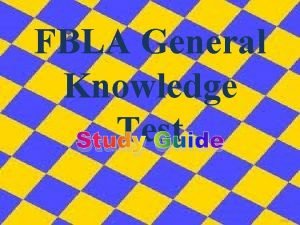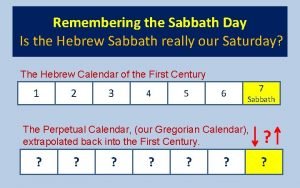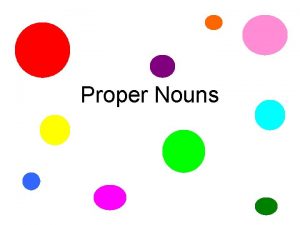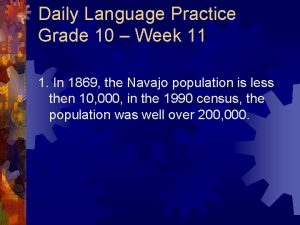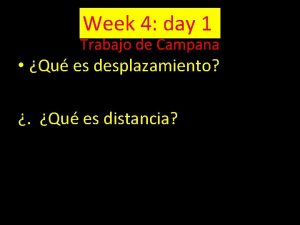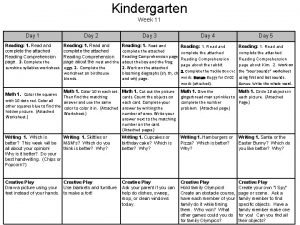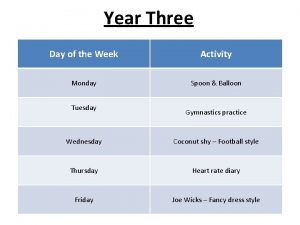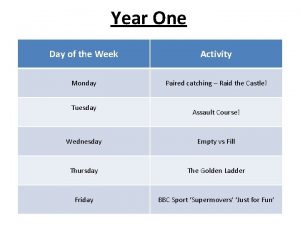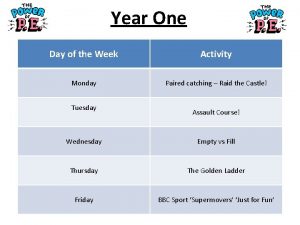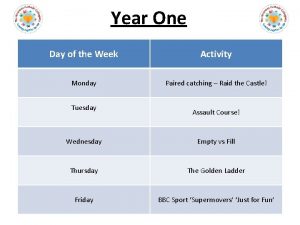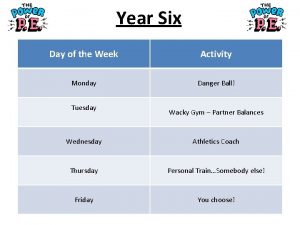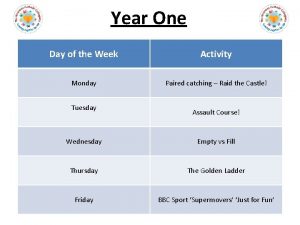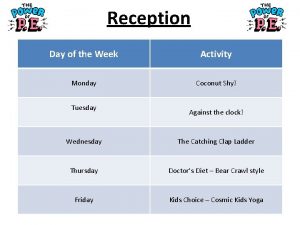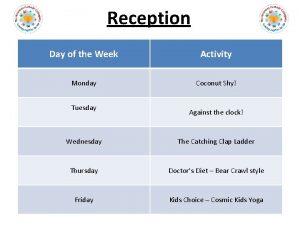Year Three Day of the Week Activity Monday
















- Slides: 16

Year Three Day of the Week Activity Monday Spoon & Balloon Tuesday Gymnastics practice Wednesday Coconut shy – Football style Thursday Heart rate diary Friday Joe Wicks – Fancy dress style

Monday – Spoon & Balloon For this game you will need a spoon and a balloon per player. Very simple, silly and fun. Make a start line and a finish (make it a longer course with an oval/rectangle shape if you wish). The aim of the game is simple. Finish first! You must only touch the balloon with your spoon. You must cross the finish line with your balloon!

Tuesday –Gymnastics practice! We know you might be a little squished for space at the moment, but on Tuesday’s it is Gymnastics practice! You may not be able to perform a Round off – but you can practice these point balances. Remember Gymnastics judges appreciate, Control, Extension and Fluency. So tense those muscles to stay nice and still and extend your arms, legs, fingers and toes where possible!

1 Point Balances

2 Point Balances

3 Point Balances

4 Point Balances

Wednesday – Coconut Shy Football Style • Find a sensible place to play, some soft targets to aim at & grab a ball. Try and place these targets at a variety of heights to test your skills • Decide on how many goes each you have and take it in turns to see who can throw the socks and knock over the most targets. • To make it harder – use smaller targets or move further away!

Thursday – Heart Rate Diary Today you will conduct a science experiment! As you know you heart rate (how fast your heart beats) changes depending on how your body is moving. On Thursdays you need to try lots of different types of moving your body. There is one rule – you just complete the exercise for at least 2 minutes before you take your pulse. Then simply fill out the log on the sheet (or copy it and write it down on some scrap paper). Enjoy!

Type of Activity Heart Rate (How fast your heart is beating)

Friday – Joe Wicks Fancy Dress • On Friday Joe Wicks encourages people to dress up and join in with his online work outs. • Dress up and get moving. Enjoy! • https: //www. youtube. com/user/thebodycoac h 1

“I can do that…. What’s next? ”

Progressions: Balance Increas e in Compl • Children can maintain balance when performing a task on one leg (this applies when static or when moving) (Develop through setting challenges where children must perform tasks on one leg. I. e – Throw and catch bean bag with alternate hands on one leg – Individual or as pairs) • Children can maintain their balance whilst standing on one foot (Set time challenges, use apparatus to focus children. Encourage the children to look at something that is level with their eyes – ears govern our balance! Some children will initially find it easier balancing with a bend in their knee, allowing the Quadriceps to contract slightly and control their body) • Children maintain their balance whilst standing in a stationary position and performing a task (2 feet) (Develop by asking children to balance a bean bag on their shoulder>back of As children develop their balance, ask them to hold their limbs further away from their core!

Progressions: Catching • Standing – Using two bean bags! • Standing – Practice catching with a medium sized ball • Resting on knee’s – Practice catching with a medium sized ball • Sitting – practice catching with a medium sized ball • Standing – Practice catching with a bean bag Individual • Resting on knee’s – Increas Practice catching e in with a bean bag Compl • Standing – Using two bean bags! • Standing – Practice catching with a medium sized ball • Resting on knee’s – Practice catching with a medium sized ball • Sitting – practice catching with a medium sized ball • Standing – Practice catching with a bean bag In on Pairs • Resting knee’s – Practice catching with a bean bag • Large group working in a set space, one child acts as the DEF, the rest keep ball away from DEF • Standing in a circle, no adult in the middle, practice catching with a medium sized ball • In a circle, no adult in middle, practice catching a bean bag • Standing in a circle, adult in the middle, In a catching Small practice with a Group medium sized ball

Progressions: Running & Stopping Increas e in Compl • Children maintain balance when moving fast in all directions & changing directions. Children react to variables and maintain balance whilst moving in a range of directions and stopping with competency (Development would now begin to integrate other factors such as another FMS – Kicking, Catching, Throwing, Jumping etc) • Children maintain their balance when changing direction in a regimented fashion, show an understanding that not crossing legs when changing direction helps them to maintain balance (Development would then focus on activities/games requiring children dodging, chasing, avoiding moving objects/people) • Children maintain their balance when moving forwards, show an understanding that bending at the knee helps them to stop quickly. Struggle When changing direction DON’T cross your feet!

Progressions: Throwing • Can utilise the overarm throw to a target/area with moderate success (a greater distance away) • Begins to use the over-arm throw to throw over a greater distance • Can throw objects under-arm to targets 3 -4 metres away with moderate success • Can throw objects under-arm to targets Individual 1 -2 metres away with Increas e in moderate success • Can throw objects Compl • Children select • Can utilise the overappropriate types arm throw to of throw, reacting the chest with to changing moderate success (a situations in game greater distance away) play successfully • Begins to use the over(bounce pass to arm throw to throw avoid defender) over a greater distance • Children can use (close to partner’s teaching points to chest) successfully • Can throw objects complete different under-arm to chest 3 types of throw on 4 metres away with command moderate success • Children can list • Can throw objects the teaching points under-arm to chest 1 In Pairs Activity of different types 2 metres away with specific of throw (I. e – How moderate success to perform a chest • Can throw objects
 Monday my favorite day
Monday my favorite day Day 1 day 2 day 3 day 4
Day 1 day 2 day 3 day 4 Enum day sunday=1 monday tuesday=5
Enum day sunday=1 monday tuesday=5 Day 1 day 2 day 817
Day 1 day 2 day 817 Monday question of the day
Monday question of the day Week by week plans for documenting children's development
Week by week plans for documenting children's development Days of the week and months of the year
Days of the week and months of the year Knowledge check meeting engagement fbla
Knowledge check meeting engagement fbla 8 day week
8 day week A noun names
A noun names 5 a day language review week 9
5 a day language review week 9 Pros and cons of a 4 day school week
Pros and cons of a 4 day school week Now upon the first day of the week
Now upon the first day of the week Dgp week 11
Dgp week 11 Week 4 day 1
Week 4 day 1 Week 11 day 3
Week 11 day 3 Holy week day 1
Holy week day 1







